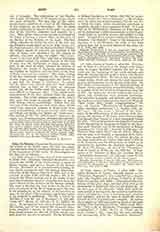

John the Deacon (JOHANNES DIACONUS).—Among the writers of the Middle Ages who bear this name, four historians deserve particular mention on account of the importance of their work. In chronological order they are as follows:
(I) John, deacon of Rome, date of birth unknown; d. before 882. Johannes, surnamed Hymonides, was towards the middle of the ninth century a monk of Monte Cassino, and later a deacon of the Roman Church. Possessed of no inconsiderable learning, he was closely associated with the learned Anastasius, Librarian of the Roman Church (d. 879), and at the instance of John VIII (872-82) wrote a life of St. Gregory the Great, making use of the works of this pope and of extracts made at an earlier date from the pope’s letters in the archives of the Roman Church. The work is divided into four books: in the first he gives an account of the life of Gregory up to the time of his pontificate; in the second, of his activities as pope; in the third, of his teachings; and in the fourth, of his progress in perfection. The life is edited by Mabillon (“Acta SS. ord. S. Benedicti”, I, 398-496; “Acta SS.”, March, II, 137-211; P.L., LXXV, 50 sqq.). He intended to write also a detailed history of the Church, and at his request the aforesaid Anastasius compiled a history in three parts (tripartita) from Greek sources for the use of John, whose purpose, however, was never executed. On the invitation of Bishop Gaudericus of Velletri (867-79), he undertook to reedit the “Gesta Clementis”, a life of Clement I (d. about end of first century), but did not live to finish the work, which Gaudericus undertook to complete, though it never appeared in full. It is said that in the Bibliotheque Nationale at Paris there is yet in manuscript a short commentary on the Heptateuch based on patristic sources and written by this John. A letter from a certain Johannes Diaconus to Senarius, “vir illustris”, treats of the ceremonies of baptism; it is not however, the work of the John treated here, but of an older deacon of this name (ed. P.L., LIX, 399-408).
(2) John, deacon of Naples, d. after 910. This deacon, or head of a diaconia at the church of St. Januarius of Naples, flourished towards the end of the ninth and the beginning of the tenth century, and from his writings appears to have been a very learned and accomplished cleric. We owe to him several historical works, which are among the most important sources of information for the history of his time. He first wrote a continuation of the diocesan history of Naples (Gesta episcoporum Neapolitanorum), begun by another cleric, but which he brings down from 762 to 872. He makes use of both written and oral tradition, and contributes from personal knowledge. The narrative is graphic and spirited, and impresses the reader as a frank and accurate story (ed. Waitz in “Mon. Germ. Hist.: Script. Langobardorum”, 398 sqq.; ed. Capasso, “Monumenta ad Neapolitani ducatus historiam pertinentia”, I, Naples, 1881, pp. 307 sqq.). He also wrote a history of the translation in the fifth century of the remains of St. Severinus, the Apostle of Noricum, from the Castellum Lucullanum near Naples to a new monastery within the city. This work contains the important account of the destruction of Taormina in Sicily by the Saracens under Ibrahim, and of the martyrdom of Bishop Procopius (ed. “Acta SS.”, January, I, 1098 sqq; ed. Waitz in “Mon. Germ. Hist.”, loc. cit., 452-9). When in 910 the relics of St. Sossius, a companion of St. Januarius, were transferred from the ruined Messina to the same monastery at Naples, John wrote a history of St. Januarius and his companions, in which as an eyewitness he describes the aforesaid transfer (Acta SS., September, VI, 874 sqq.; the text of the “Translatio” alone is found in Waitz, be. cit., 459-63). A biography of St. Nicholas of Mira (ed. Cardinal Mai in “Spicilegium Romanum”, IV, 323 sqq.) is not by this John but by another author of the same name.
(3) John, deacon of Venice, d. after 1008. The oldest chronicle of Venice, formerly known as the “Chronicon Sagornini”, was compiled by a deacon John, the chaplain and perhaps a relative of Doge Peter II Urseolus (991-1009). John enjoyed the confidence of this great doge, and was often sent as his ambassador to Emperors Otto III and Henry II. In the first part of his chronicle, which deals with the early period of the republic, the narrative is often confused and deficient; later it becomes more accurate and complete, and for the time in which the writer himself lived it is particularly valuable. He carries the narrative to 1008 and treats in detail of the reign of Doge Peter Urseolus [ed. Pertz, “Mon. Germ. Hist.: SS.”, VII, 1-36; ed. Monticolo, “Cronache Veneziane antichissime”, I (1890), 59-171, in “Fonti per la storia d’Italia”, IX]. John has also been credited, but erroneously, with the “Chronicon Gradense”, which is in the manuscripts usually given with “Chronicon Venetum”.
(4) John, a Roman deacon, lived in the second half of the twelfth century. This deacon and canon of the Lateran compiled a work on this papal basilica, and dedicated it, in the preface, to Alexander III (1159-81), thereby indicating the date of its composition. It was obviously a secondary object of the author in composing this work to support the canons of the Lateran in their dispute for precedence with the canons of St. Peter’s (ed. Mabillon, “Iter Italicum”, II, 560-76; P.L., CXCIV, 1543-50).
J. P. KIRSCH

